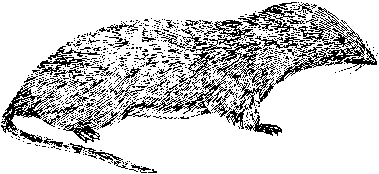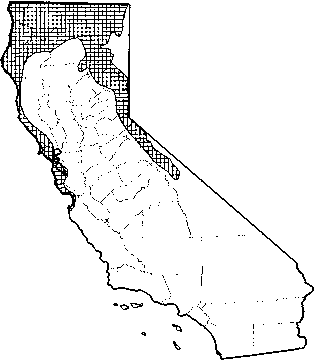
Vagrant Shrew
Distribution, Abundance, and Seasonality
The vagrant shrew is common to abundant in the Sierra Nevada and Cascades from the Oregon border to northern Inyo Co., and along the coast from the Oregon border to Monterey Bay. Optimal habitats are valley foothill and montane riparian, aspen, wet meadow, annual and perennial grasslands, and fresh and saline emergent wetlands. Also occurs in a variety of chaparral and wooded habitats. Vagrant shrews can be found in California from sea level to 3750 m (12,000 ft).

Range Map
Specific Habitat Requirements
Feeding: Feeds mainly on invertebrates: insects, worms, snails, slugs, and spiders. Also eats fungi, small mammals, roots, young shoots, and probably seeds. Forages under litter on moist surfaces, underground, and in moist accumulations of dead plant material. Whitaker et al. (1983) reported it ate more flying insects and caterpillars, and fewer terrestrial insects and worms, when grazing pressure was heavy.
Cover: Prefers dense litter or ground cover. Uses vole runways.
Reproduction: Makes a nest of dry grass, moss, or other materials under logs, roots, or dense vegetation.
Water: This species may require water. Clothier (1955) reported that vagrant shrews were not found farther than 180 m (600 ft) from water.
Pattern: Prefers patchy, open areas with wet micro-habitats such as damp meadows and streambanks.
Species Life History
Activity Patterns: Active yearlong. May be captured day or night, though most activity is nocturnal.
Seasonal Movements / Migration: None reported.
Home Range: Breeding home ranges averaged 0.33 ha (0.82 ac), ranging from 0.07-0.53 ha (0.18-1.3 ac) (Hawes 1977). Nonbreeding home ranges averaged 0.10 ha (0.26 ac), ranging from 0.05-0.20 ha (0.13-0.49 ac) (Hawes 1977). Juvenile home ranges were similar to those of nonbreeding adults.
Territory: Adults are solitary except for breeding season, when there is extensive home range overlap. Adults begin defending their home ranges from other adults (not juveniles) in late summer and continue to do so until the next mating season.
Reproduction: After a 20-day gestation period, most young are born from March to May. There may be a second peak of births in August and September. Litter size averages 6 (range 2-9), and there are 1 or 2 (rarely, 3) litters per year. The young are weaned 16-20 days after birth. Females may breed in their first year, and the maximum lifespan is about 16 mo. Most shrews do not live to breed a second year.
Niche: This small insectivore is sympatric with several shrew species. Along the coast, the vagrant shrew prefers more open, grassy situations than the forest dwellers S. pacificus and S. trowbridgii. In the Sierra Nevada, the vagrant shrew tends to occur at lower elevations than the dusky shrew and to show a weaker relationship to water (Ingles 1961, Spencer and Pettus 1966, Hennings and Hoffmann 1977, but see Hawes 1977). Predators include owls. Populations may be reduced or increased by clear-cutting and burning (Black and Hooven 1974, Ramirez and Hornocker 1981), depending on habitat. Populations reduced by applications of DDT (Herman and Bulger 1979).
Comments: Several references thought to pertain to S. vagrans actually pertain to S. monticolus (Hennings and Hoffmann 1977). These include Ingles (1961) and Spencer and Pettus (1966). Populations of S. v halicoetes are restricted to salt marshes in San Francisco Bay. Most suitable habitat has been lost to development. These shrews, which prefer a low, dense cover of salicornia, occur in low densities and may require protection. S. v. halicoetes is a California Species of Special Concern (Williams 1986).
Sources & References
California Department of Fish and Game, 1999.
California's Wildlife, Sacramento, CA.
Written by: J. Harris, reviewed by: H. Shellhammer, edited by: S. Granholm, R. Duke
Black, H. C., and E. F. Hooven. 1974. Responses of small mammal communities to habitat changes in western Oregon. Pages 177-186 in Proc. Symp. Wildl. For. Manage. Pac. Northwest. Oregon State Univ., School For., Corvallis. 236pp. Clothier, R. R. 1955. Contribution to the life history of Sorex vagrans in Montana. J. Mammal. 36:214-221. Findley, J. S. 1955. Speciation of the wandering shrew. Univ. Kans. Publ., Mus. Nat. Hist. 9:1-68. Grinnell, J., and T. I. Storer. 1924. Animal life in the Yosemite. Univ. California Press, Berkeley. 752pp. Hawes, M. L. 1977. Home range, territoriality, and ecological separation in sympatric shrews, Sorex vagrans and Sorex obscurus. J. Mammal. 58:354-367. Hennings, D., and R. S. Hoffmann. 1977. A review of the taxonomy of the Sorex vagrans species complex from western North America. Univ. Kans. Publ., Mus. Nat. Hist. 68:1-35. Herman, S. G., and J. B. Bulger. 1979. Effects of a forest application of DDT on nontarget organisms. Wildl. Monogr. 69:1-62. Hooven, E. F., R. F. Hoyer, and R. M. Storm. 1975. Notes on the vagrant shrew, Sorex vagrans, in the Willamette Valley of western Oregon. Northwest Sci. 49:163-173. Ingles, L. G. 1961. Home range and habits of the wandering shrew. J. Mammal. 42:455- 462. Johnston, R. F., and R. L. Rudd. 1957. Breeding of the salt marsh shrew. J. Mammal. 38:157-163. Ramirez, P. M., Jr., and M. Hornocker. 1981. Small mammal populations in different-aged clearcuts in northeastern Montana. J. Mammal. 62:400-403. Rudd, R. L. 1955a. Age, sex, and weight comparisons in three species of shrews. J. Mammal. 36:323-339. Rudd, R. L. 1955b. Population variation and hybridization in some Californian shrews. Syst. Zool. 4:21-34. Spencer, A. W., and D. Pettus. 1966. Habitat preference of five sympatric species of long tailed shrews. Ecology 47:677-683. Terry, C. J. 1981. Habitat differentiation among three species of Sorex and Neurotrichus gibbsii in Washington, USA. Am. Midl. Nat. 106:119-125. Whitaker, J. O., Jr., and C. Maser. 1976. Food habits of five western Oregon shrews. Northwest Sci. 50:102-107.
Whitaker, J. O., Jr., S. P. Cross, and C. Maser. 1983. Food of vagrant shrews (Sorex vagrans) from Grant Co., Oregon, as related to livestock grazing pressures. Northwest Sci. 57:107-111.
Williams, D. F. 1986. Mammalian species of special concern in California. Calif. Dept. Fish and Game, Sacramento. Admin. Rep. 86-1. 112pp.
California Animal Facts | California's Wildlife